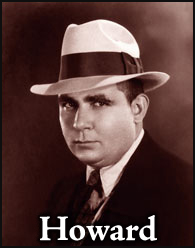The Cimmerian V5n4 — August 2008

Edited by Leo Grin | Illustrated by Socar Myles
40 pages
This issue was printed in two editions. The deluxe edition, numbered 1–75, uses a black linen cover with foil-stamped amethyst text. The limited edition, numbered 76–225, uses an amethyst cover with solid black text.
DELUXE COPIES DESTROYED: 20
LIMITED COPIES DESTROYED: 70
Features a lengthy essay on Howard’s relationship with the standout pulp Argosy, a piece on the tantalizing theme of devolution within REH’s invented history, a trip report from Howard Days 2008, a quick rundown of the 2008 Cimmerian Awards, plus poetry by Donald Sidney-Fryer, art from Socar Myles, and the Lion’s Den letters column.
EXCERPTS:
That was the dream Howard lived on as he sat for hours at the typewriter in his small room: to crack the pages of Argosy or Adventure, Blue Book or Short Stories, to move on to the slick, coated-stock pages of magazines such as The Saturday Evening Post, to see books with his byline reach print.
The young Texan was by no means the first to feel such ambition as popular fiction roared into the twentieth century. Edgar Rice Burroughs made one of the definitive statements summing up the idea of the avid fiction reader deciding that he too could become a writer, because Burroughs knew from his diet of pulp fiction that “…if people were paid for writing rot such as I read in some of those magazines that I could write stories just as rotten. As a matter of fact, although I had never written a story, I knew absolutely that I could write stories just as entertaining and probably a whole lot more so than any I chanced to read in those magazines.” Thomas Newell Metcalf accepted his first novel “Under the Moons of Mars,” introducing the daring swordsman John Carter, for serialization in The All-Story from February through July 1912 — mere months before Burroughs reached his thirty-seventh birthday on September 1 of that year.
— from “Conan the Argonaut” by Morgan Holmes and George Knight
“In that utter desolation only they moved,” Howard writes of the stunning two-man tableau that opens “The Frost-Giant’s Daughter,” “…Slowly through the corpses they came, as ghosts might come to a tryst through the shambles of a dead world.” Ghosts, a tryst, the shambles of a dead world — how perfectly this imagery applies, on a far grander scale, to the red meeting of the surviving Picts and the remaining Atlanteans of the aftermath-age, in a haunted West of jungles, mountains, and a few cities not erased by earthquakes and eruptions, now but mausoleums for the bygone Thurian civilization.
— from “Long Falls and Hard Climbs” by Steven Tompkins
While these events were going on, a camera crew from Godspeed Productions of West Hollywood was filming the activities and interviewing attendees. They are making an independent documentary on Howard Days, which they hope to release by this time next year. A second documentarian connected with NBC was also filming the proceedings. His film intends to give an intimate look at Howard as a person and artist through quotations from stories, poems, and letters.
— from “The Best Little Lore House in Texas” by Lee Breakiron
I have in my files twenty-five collections (nearly nil duplication) of Lovecraft’s letters, and there are probably a few more I’ve missed along the way. There are also those from the “transcription project” reposing in the electronic files of Joshi and David E. Schultz. When Brian writes “questions would be answered if the Lovecraft letters weren’t seemingly so heavily edited in places — but until we see the complete versions I believe it is allowable to speculate” (V4n2), I say “wrong, there are enough un-edited Lovecraft letters extant to satisfy almost any argument.”
— John Haefele, writing in The Lion’s Den




